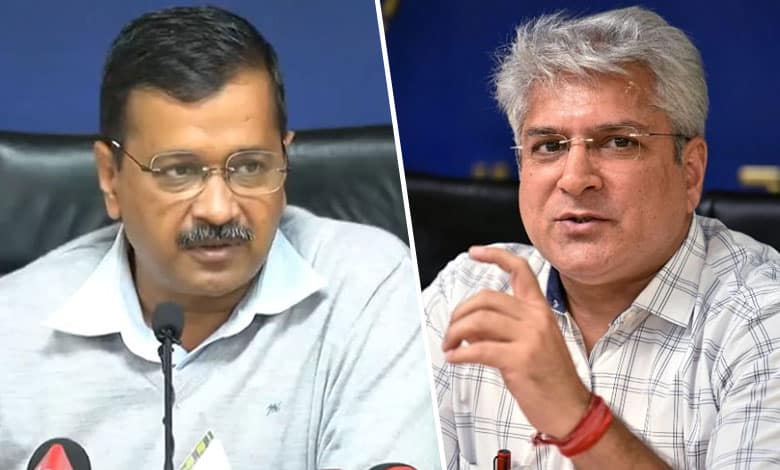Kailash Gahlot Resigns from AAP: Flag Controversy and Internal Strife Behind the Rift with Arvind Kejriwal
Senior Aam Aadmi Party (AAP) leader and Delhi Minister, Kailash Gahlot, resigned from the party today, marking a significant rift in the party's leadership.

New Delhi: Senior Aam Aadmi Party (AAP) leader and Delhi Minister, Kailash Gahlot, resigned from the party today, marking a significant rift in the party’s leadership. While the resignation has been attributed to several factors, sources close to the party reveal that the seeds of discord were sown during the 2023 Independence Day celebrations when Gahlot’s role in the flag-hoisting ceremony became a flashpoint.
Table of Contents
The August 15 Flag Controversy: Catalyst for the Rift
The controversy erupted on August 15, when the task of unfurling the national flag during Delhi’s Independence Day celebrations fell under scrutiny in the absence of Chief Minister Arvind Kejriwal. Kejriwal was in jail at the time, facing charges related to the alleged liquor policy scam.
Kejriwal had initially directed that Atishi, the then Delhi Education Minister, should perform the ceremonial duty of hoisting the flag. However, Delhi’s Lieutenant Governor (LG) VK Saxena intervened, deeming Kejriwal’s directive invalid. The LG appointed Kailash Gahlot, the Delhi Home Minister, to carry out the task, citing the Home Department’s oversight of the Delhi Police, which organizes the ceremonial march-past.
Also Read: BJP’s New Rule: Khatibs Must Get Waqf Board Approval Before Delivering Friday Khutba: Owaisi Reacts
This move by the Lt Governor led to a public clash between the AAP-led Delhi government and the LG’s office. The AAP accused the Lieutenant Governor of undermining the elected government’s authority and branded the decision as “petty politics.” Atishi, in particular, slammed the decision, calling it an act of “dictatorship” and questioning the BJP’s commitment to democratic norms.
While the political battle over the flag-hoisting ceremony raged on, Gahlot’s decision to comply with the LG’s directive appeared to strain his relationship with Kejriwal and the AAP leadership.
Rising Tensions: From the Flag Controversy to the “Sheeshmahal” Debacle
The tensions between Gahlot and the AAP leadership deepened further in December when the Delhi government’s Law Department, previously overseen by Gahlot, was taken from him and handed over to Atishi. Sources within the party suggest that the move was prompted by the increasing backlog of work in the Law Department. However, it became another point of contention, fueling the growing rift between Gahlot and the leadership.
In his resignation letter, Gahlot did not mince words, addressing the “embarrassing and awkward” controversies that had plagued the party. He particularly pointed to the “Sheeshmahal” controversy—referring to the alleged excessive expenditure on Kejriwal’s residence—which had become a source of mockery and criticism.
Gahlot wrote, “I also want to share with you that today the Aam Aadmi Party faces grave challenges. Challenges from within, to the very values that brought us together to AAP. Political ambitions have overtaken our commitment towards people, leaving many promises unfulfilled.”
A Bitter Exit: Gahlot’s Reflections on AAP’s Failures
In his resignation letter, Gahlot expressed disappointment with the party’s shifting priorities. He highlighted the unfulfilled promise of cleaning the Yamuna River, which had worsened over time, as an example of AAP’s failure to deliver on its commitments. “The Yamuna is perhaps even more polluted than ever before,” Gahlot wrote.
He also lamented that the party had increasingly focused on internal power struggles and political ambitions, rather than working for the welfare of Delhi’s residents. Gahlot’s letter further criticized AAP for engaging in constant battles with the central government, instead of addressing the pressing issues affecting the city.
“Instead of fighting for people’s rights, we have increasingly only been fighting for our own political agenda. This has severely crippled our ability to even deliver basic services to the people of Delhi,” Gahlot added.
BJP Seizes the Moment
The resignation of Kailash Gahlot has become a political opportunity for the Bharatiya Janata Party (BJP), which quickly framed the move as evidence of AAP’s internal discord and failure to meet its promises to the people of Delhi. BJP leaders have seized on Gahlot’s resignation as proof of the growing disillusionment within AAP, accusing the party of being more focused on political infighting than on governance.
BJP spokespersons have called for a thorough investigation into the AAP government’s failures, pointing to issues like pollution, healthcare, and public infrastructure, which remain pressing concerns for Delhi residents.
Conclusion: AAP Faces Uncertainty Amid Growing Strain
Kailash Gahlot’s resignation marks a significant moment in AAP’s political trajectory. What started as a small disagreement over the Independence Day flag-hoisting ceremony has evolved into a much larger dispute within the party. With Gahlot now out of the picture, questions remain about the future of AAP’s internal dynamics and its ability to deliver on its promises to the people of Delhi.
As the political storm rages, the AAP leadership will now have to address the issues raised by Gahlot and work to resolve the internal conflicts that threaten to undermine the party’s credibility and unity.
